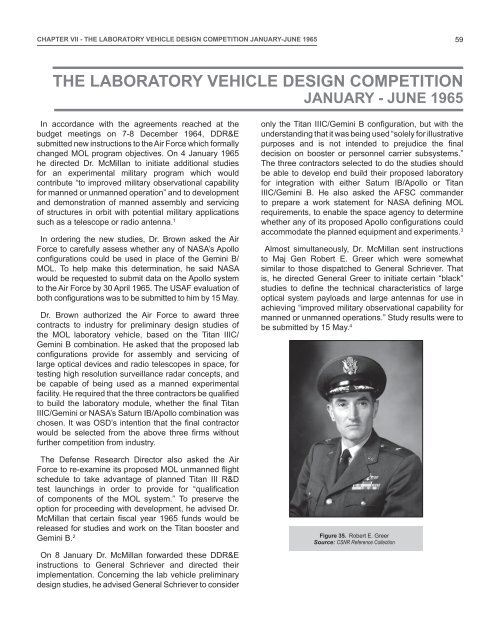NRO-MOL_2015
Create successful ePaper yourself
Turn your PDF publications into a flip-book with our unique Google optimized e-Paper software.
Chapter VII - THE LABORATORY VEHICLE DESIGN COMPETITION January-June 1965<br />
59<br />
THE LABORATORY VEHICLE DESIGN COMPETITION<br />
January - June 1965<br />
In accordance with the agreements reached at the<br />
budget meetings on 7-8 December 1964, DDR&E<br />
submitted new instructions to the Air Force which formally<br />
changed <strong>MOL</strong> program objectives. On 4 January 1965<br />
he directed Dr. McMillan to initiate additional studies<br />
for an experimental military program which would<br />
contribute “to improved military observational capability<br />
for manned or unmanned operation” and to development<br />
and demonstration of manned assembly and servicing<br />
of structures in orbit with potential military applications<br />
such as a telescope or radio antenna. 1<br />
In ordering the new studies, Dr. Brown asked the Air<br />
Force to carefully assess whether any of NASA’s Apollo<br />
configurations could be used in place of the Gemini B/<br />
<strong>MOL</strong>. To help make this determination, he said NASA<br />
would be requested to submit data on the Apollo system<br />
to the Air Force by 30 April 1965. The USAF evaluation of<br />
both configurations was to be submitted to him by 15 May.<br />
Dr. Brown authorized the Air Force to award three<br />
contracts to industry for preliminary design studies of<br />
the <strong>MOL</strong> laboratory vehicle, based on the Titan IIIC/<br />
Gemini B combination. He asked that the proposed lab<br />
configurations provide for assembly and servicing of<br />
large optical devices and radio telescopes in space, for<br />
testing high resolution surveillance radar concepts, and<br />
be capable of being used as a manned experimental<br />
facility. He required that the three contractors be qualified<br />
to build the laboratory module, whether the final Titan<br />
IIIC/Gemini or NASA’s Saturn IB/Apollo combination was<br />
chosen. It was OSD’s intention that the final contractor<br />
would be selected from the above three firms without<br />
further competition from industry.<br />
The Defense Research Director also asked the Air<br />
Force to re-examine its proposed <strong>MOL</strong> unmanned flight<br />
schedule to take advantage of planned Titan III R&D<br />
test launchings in order to provide for “qualification<br />
of components of the <strong>MOL</strong> system.” To preserve the<br />
option for proceeding with development, he advised Dr.<br />
McMillan that certain fiscal year 1965 funds would be<br />
released for studies and work on the Titan booster and<br />
Gemini B. 2<br />
On 8 January Dr. McMillan forwarded these DDR&E<br />
instructions to General Schriever and directed their<br />
implementation. Concerning the lab vehicle preliminary<br />
design studies, he advised General Schriever to consider<br />
only the Titan IIIC/Gemini B configuration, but with the<br />
understanding that it was being used “solely for illustrative<br />
purposes and is not intended to prejudice the final<br />
decision on booster or personnel carrier subsystems.”<br />
The three contractors selected to do the studies should<br />
be able to develop end build their proposed laboratory<br />
for integration with either Saturn IB/Apollo or Titan<br />
IIIC/Gemini B. He also asked the AFSC commander<br />
to prepare a work statement for NASA defining <strong>MOL</strong><br />
requirements, to enable the space agency to determine<br />
whether any of its proposed Apollo configurations could<br />
accommodate the planned equipment and experiments. 3<br />
Almost simultaneously, Dr. McMillan sent instructions<br />
to Maj Gen Robert E. Greer which were somewhat<br />
similar to those dispatched to General Schriever. That<br />
is, he directed General Greer to initiate certain “black”<br />
studies to define the technical characteristics of large<br />
optical system payloads and large antennas for use in<br />
achieving “improved military observational capability for<br />
manned or unmanned operations.” Study results were to<br />
be submitted by 15 May. 4<br />
Figure 35. Robert E. Greer<br />
Source: CSNR Reference Collection

















